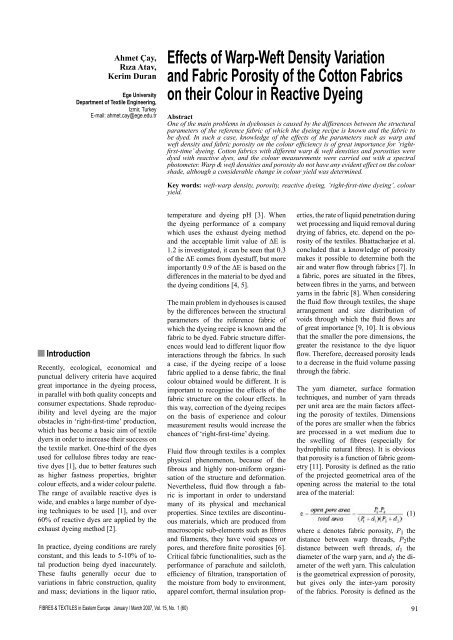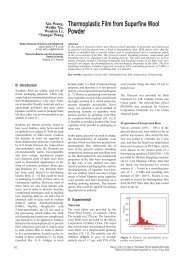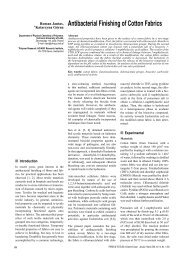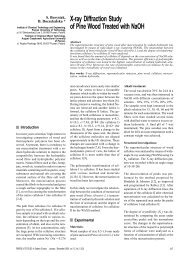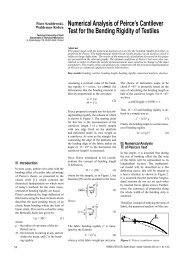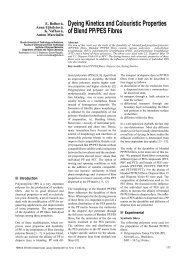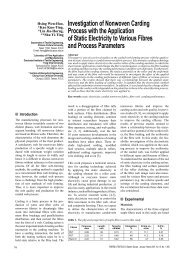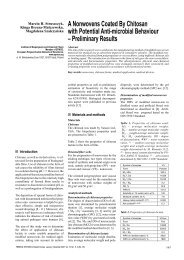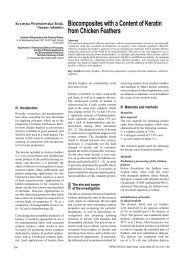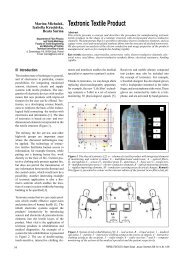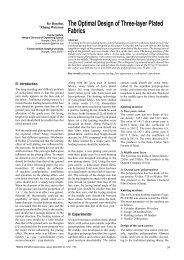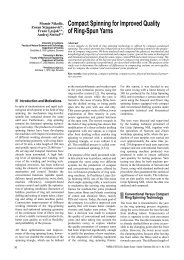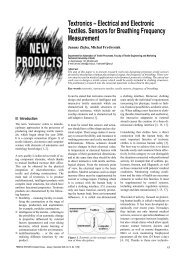Effects of Warp-Weft Density Variation and Fabric - Fibres & Textiles ...
Effects of Warp-Weft Density Variation and Fabric - Fibres & Textiles ...
Effects of Warp-Weft Density Variation and Fabric - Fibres & Textiles ...
You also want an ePaper? Increase the reach of your titles
YUMPU automatically turns print PDFs into web optimized ePapers that Google loves.
n Introduction<br />
Ahmet Çay,<br />
Rıza Atav,<br />
Kerim Duran<br />
Recently, ecological, economical <strong>and</strong><br />
punctual delivery criteria have acquired<br />
great importance in the dyeing process,<br />
in parallel with both quality concepts <strong>and</strong><br />
consumer expectations. Shade reproducibility<br />
<strong>and</strong> level dyeing are the major<br />
obstacles in ‘right-first-time’ production,<br />
which has become a basic aim <strong>of</strong> textile<br />
dyers in order to increase their success on<br />
the textile market. One-third <strong>of</strong> the dyes<br />
used for cellulose fibres today are reactive<br />
dyes [1], due to better features such<br />
as higher fastness properties, brighter<br />
colour effects, <strong>and</strong> a wider colour palette.<br />
The range <strong>of</strong> available reactive dyes is<br />
wide, <strong>and</strong> enables a large number <strong>of</strong> dyeing<br />
techniques to be used [1], <strong>and</strong> over<br />
60% <strong>of</strong> reactive dyes are applied by the<br />
exhaust dyeing method [2].<br />
In practice, dyeing conditions are rarely<br />
constant, <strong>and</strong> this leads to 5-10% <strong>of</strong> total<br />
production being dyed inaccurately.<br />
These faults generally occur due to<br />
variations in fabric construction, quality<br />
<strong>and</strong> mass; deviations in the liquor ratio,<br />
FIBRES & TEXTILES in Eastern Europe January / March 2007, Vol. 15, No. 1 (60)<br />
<strong>Effects</strong> <strong>of</strong> <strong>Warp</strong>-<strong>Weft</strong> <strong>Density</strong> <strong>Variation</strong><br />
<strong>and</strong> <strong>Fabric</strong> Porosity <strong>of</strong> the Cotton <strong>Fabric</strong>s<br />
on their Colour in Reactive Dyeing<br />
Ege University<br />
Department <strong>of</strong> Textile Engineering,<br />
Izmir, Turkey<br />
E-mail: ahmet.cay@ege.edu.tr Abstract<br />
One <strong>of</strong> the main problems in dyehouses is caused by the differences between the structural<br />
parameters <strong>of</strong> the reference fabric <strong>of</strong> which the dyeing recipe is known <strong>and</strong> the fabric to<br />
be dyed. In such a case, knowledge <strong>of</strong> the effects <strong>of</strong> the parameters such as warp <strong>and</strong><br />
weft density <strong>and</strong> fabric porosity on the colour efficiency is <strong>of</strong> great importance for ‘rightfirst-time’<br />
dyeing. Cotton fabrics with different warp & weft densities <strong>and</strong> porosities were<br />
dyed with reactive dyes, <strong>and</strong> the colour measurements were carried out with a spectral<br />
photometer. <strong>Warp</strong> & weft densities <strong>and</strong> porosity do not have any evident effect on the colour<br />
shade, although a considerable change in colour yield was determined.<br />
Key words: weft-warp density, porosity, reactive dyeing, ‘right-first-time dyeing’, colour<br />
yield.<br />
temperature <strong>and</strong> dyeing pH [3]. When<br />
the dyeing performance <strong>of</strong> a company<br />
which uses the exhaust dyeing method<br />
<strong>and</strong> the acceptable limit value <strong>of</strong> ∆E is<br />
1.2 is investigated, it can be seen that 0.3<br />
<strong>of</strong> the ∆E comes from dyestuff, but more<br />
importantly 0.9 <strong>of</strong> the ∆E is based on the<br />
differences in the material to be dyed <strong>and</strong><br />
the dyeing conditions [4, 5].<br />
The main problem in dyehouses is caused<br />
by the differences between the structural<br />
parameters <strong>of</strong> the reference fabric <strong>of</strong><br />
which the dyeing recipe is known <strong>and</strong> the<br />
fabric to be dyed. <strong>Fabric</strong> structure differences<br />
would lead to different liquor flow<br />
interactions through the fabrics. In such<br />
a case, if the dyeing recipe <strong>of</strong> a loose<br />
fabric applied to a dense fabric, the final<br />
colour obtained would be different. It is<br />
important to recognise the effects <strong>of</strong> the<br />
fabric structure on the colour effects. In<br />
this way, correction <strong>of</strong> the dyeing recipes<br />
on the basis <strong>of</strong> experience <strong>and</strong> colour<br />
measurement results would increase the<br />
chances <strong>of</strong> ‘right-first-time’ dyeing.<br />
Fluid flow through textiles is a complex<br />
physical phenomenon, because <strong>of</strong> the<br />
fibrous <strong>and</strong> highly non-uniform organisation<br />
<strong>of</strong> the structure <strong>and</strong> deformation.<br />
Nevertheless, fluid flow through a fabric<br />
is important in order to underst<strong>and</strong><br />
many <strong>of</strong> its physical <strong>and</strong> mechanical<br />
properties. Since textiles are discontinuous<br />
materials, which are produced from<br />
macroscopic sub-elements such as fibres<br />
<strong>and</strong> filaments, they have void spaces or<br />
pores, <strong>and</strong> therefore finite porosities [6].<br />
Critical fabric functionalities, such as the<br />
performance <strong>of</strong> parachute <strong>and</strong> sailcloth,<br />
efficiency <strong>of</strong> filtration, transportation <strong>of</strong><br />
the moisture from body to environment,<br />
apparel comfort, thermal insulation prop-<br />
erties, the rate <strong>of</strong> liquid penetration during<br />
wet processing <strong>and</strong> liquid removal during<br />
drying <strong>of</strong> fabrics, etc. depend on the porosity<br />
<strong>of</strong> the textiles. Bhattacharjee et al.<br />
concluded that a knowledge <strong>of</strong> porosity<br />
makes it possible to determine both the<br />
air <strong>and</strong> water flow through fabrics [7]. In<br />
a fabric, pores are situated in the fibres,<br />
between fibres in the yarns, <strong>and</strong> between<br />
yarns in the fabric [8]. When considering<br />
the fluid flow through textiles, the shape<br />
arrangement <strong>and</strong> size distribution <strong>of</strong><br />
voids through which the fluid flows are<br />
<strong>of</strong> great importance [9, 10]. It is obvious<br />
that the smaller the pore dimensions, the<br />
greater the resistance to the dye liquor<br />
flow. Therefore, decreased porosity leads<br />
to a decrease in the fluid volume passing<br />
through the fabric.<br />
The yarn diameter, surface formation<br />
techniques, <strong>and</strong> number <strong>of</strong> yarn threads<br />
per unit area are the main factors affecting<br />
the porosity <strong>of</strong> textiles. Dimensions<br />
<strong>of</strong> the pores are smaller when the fabrics<br />
are processed in a wet medium due to<br />
the swelling <strong>of</strong> fibres (especially for<br />
hydrophilic natural fibres). It is obvious<br />
that porosity is a function <strong>of</strong> fabric geometry<br />
[11]. Porosity is defined as the ratio<br />
<strong>of</strong> the projected geometrical area <strong>of</strong> the<br />
opening across the material to the total<br />
area <strong>of</strong> the material:<br />
(1)<br />
where ε denotes fabric porosity, P1 the<br />
distance between warp threads, P2the<br />
distance between weft threads, d 1 the<br />
diameter <strong>of</strong> the warp yarn, <strong>and</strong> d2 the diameter<br />
<strong>of</strong> the weft yarn. This calculation<br />
is the geometrical expression <strong>of</strong> porosity,<br />
but gives only the inter-yarn porosity<br />
<strong>of</strong> the fabrics. Porosity is defined as the<br />
91
Table 1. <strong>Fabric</strong> properties.<br />
fraction <strong>of</strong> void space in a porous medium<br />
[12]:<br />
92<br />
Sample no<br />
(2)<br />
where ρa is the fabric density (g/cm 3)<br />
<strong>and</strong> ρb is the fibre density (g/cm 3).<br />
<strong>Fabric</strong> density is calculated by dividing<br />
the fabric weight per unit area, by fabric<br />
thickness. This equation includes the inter-fibre<br />
porosity as well as the inter-yarn<br />
porosity <strong>of</strong> the fabric.<br />
This paper presents the effects <strong>of</strong> warp<br />
& weft density <strong>of</strong> woven fabrics, <strong>and</strong> in<br />
consequence the fabric porosity, on the<br />
colour shade <strong>and</strong> yield in reactive dyeing.<br />
This is known practically, although<br />
no experimental study on this subject has<br />
yet been found .<br />
n Experimental<br />
<strong>Warp</strong> density,<br />
threads/cm<br />
<strong>Weft</strong> density,<br />
threads/cm<br />
Plain weaved bleached cotton fabrics<br />
produced in different warp <strong>and</strong> weft densities<br />
were used for the purpose <strong>of</strong> investigating<br />
the effects <strong>of</strong> fabric structure <strong>and</strong><br />
porosity on colour yield. The linear yarn<br />
densities <strong>of</strong> warp <strong>and</strong> weft yarns were<br />
12 tex (Ne50) <strong>and</strong> 15 tex (Ne40) respectively.<br />
Table 1 represents the characteristics<br />
<strong>of</strong> the fabrics used.<br />
The porosity <strong>of</strong> the fabrics was calculated<br />
by using Equation (2). The mean<br />
density <strong>of</strong> cotton fibres is accepted as<br />
1.52 g/cm 3. The pore area <strong>of</strong> each fabric<br />
Porosity,<br />
%<br />
Pore area,<br />
mm2<br />
1 60 20 0,73 1,45<br />
2 60 30 0.67 0.78<br />
3 60 40 0.61 0.44<br />
4 54 40 0.63 0.64<br />
5 66 40 0.61 0.27<br />
Table 2. Dyestuff properties; (VS: Vinyl Sulphone, MCT: Monochlorotriazine).<br />
Dyestuff Remazol Yellow RR Remazol Red RR Remazol Blue RR<br />
Structure mon<strong>of</strong>unctional bifunctional bifunctional<br />
Reactive group VS MCT/VS VS/VS<br />
Reactivity medium medium medium<br />
Substantivity high high medium<br />
Table 3. Dyeing recipes for Remazol RR dyestuffs.<br />
0.5% dye concentration 2% dye concentration 1.5% combination dyeing<br />
0.5% Remazol Yellow/Red/Blue RR<br />
35 g/l Na2SO4<br />
7.5 g/l Soda<br />
2% Remazol Yellow/Red/Blue RR<br />
50 g/l Na2SO4<br />
13 g/l Soda<br />
0.5% Remazol Yellow RR<br />
0.5% Remazol Red RR<br />
0.5% Remazol Blue RR<br />
45 g/l Na2SO4<br />
11.5 g/l Soda<br />
was calculated geometrically, considering<br />
the plain weave structure with the aid<br />
<strong>of</strong> yarn diameters.<br />
Three different reactive dyes, supplied<br />
from the Dystar Company (Remazol Yellow<br />
RR, Remazol Red RR <strong>and</strong> Remazol<br />
Blue RR), were used for reactive dyeing.<br />
Table 2 represents the properties <strong>of</strong> the<br />
dyestuffs. Dyeing processes were carried<br />
out in two different dye concentrations<br />
(0.5% <strong>and</strong> 2%). Furthermore, combination<br />
dyeings <strong>of</strong> these three dyestuffs<br />
(0.5% for each one <strong>and</strong> a total <strong>of</strong> 1.5%)<br />
were also processed.<br />
Reactive dyeing was carried out with a<br />
laboratory-scale HT Termal dyeing machine<br />
with a liquor ratio <strong>of</strong> 1:15 according<br />
to the 30 °C → 60 °C temperature<br />
rise method. The dyeing process was<br />
started with a liquor containing alkaline,<br />
salt <strong>and</strong> dyestuff at 30 °C, <strong>and</strong> after<br />
10 minutes the temperature was raised<br />
to 60 °C with a 1 °C/min temperature<br />
rise ratio; the samples were then treated<br />
for 60 minutes. The dyeing recipe is presented<br />
in Table 3. After dyeing, the samples<br />
are rinsed <strong>and</strong> neutralised (10 min. at<br />
60 °C with 0.5 g/l acetic acid), <strong>and</strong> then<br />
rinsed at 80 °C for 10 minutes, 95 °C for<br />
15 minutes (two times for 2% dyeings),<br />
80 °C for 10 minutes, <strong>and</strong> 5 minutes in<br />
cold water.<br />
The reflection (%R) <strong>and</strong> CIELab values<br />
<strong>of</strong> the samples were measured with a Mi-<br />
nolta 3600d spectral photometer with a<br />
10° normal observer <strong>and</strong> norm light D65.<br />
The colour yields <strong>of</strong> the dyed samples<br />
were calculated by the Kubelka-Munk<br />
equation [13]:<br />
(3)<br />
where R is the reflectance at maximum<br />
absorption wavelength (nm), K the absorption<br />
coefficient <strong>and</strong> S the scattering<br />
coefficient.<br />
The colour differences are expressed as<br />
∆E, which is calculated by the following<br />
equation:<br />
(4)<br />
where ∆E* is the CIELAB colour difference<br />
between batch <strong>and</strong> st<strong>and</strong>ard.<br />
Here ∆L*, ∆a*, ∆b* <strong>and</strong> hence ∆E*,<br />
are in commensurate units. ∆L* denotes<br />
the difference between lightness (where<br />
L* = 100) <strong>and</strong> darkness (where L* = 0),<br />
∆a* the difference between green (-a*)<br />
<strong>and</strong> red (+a*), <strong>and</strong> ∆b* the difference<br />
between yellow (+b*) <strong>and</strong> blue (-b*).<br />
n Results <strong>and</strong> discussion<br />
<strong>Effects</strong> <strong>of</strong> fabric density variation<br />
Tables 4, 5 <strong>and</strong> 6 represent L*, a*, b*<br />
values <strong>and</strong> ∆L*, ∆a*, ∆b* <strong>and</strong> ∆E values<br />
(calculated with reference to the sample<br />
with weft density <strong>of</strong> 20 threads/cm) <strong>of</strong><br />
the reactive dyed fabrics considering<br />
weft density variation.<br />
The ∆a* <strong>and</strong> ∆b* values calculated<br />
with reference to the sample with weft<br />
density <strong>of</strong> 20 threads/cm show that the<br />
increase in weft density does not have a<br />
significant effect on the colour shade <strong>of</strong><br />
the reactive dyed fabrics both for 0.5%<br />
<strong>and</strong> 2% dye concentrations. However,<br />
the increase <strong>of</strong> weft density has the main<br />
effect on the L* values <strong>of</strong> the samples.<br />
Due to the increase <strong>of</strong> weft density, the<br />
fabrics become denser, <strong>and</strong> this makes<br />
the penetration <strong>of</strong> the dyestuffs into the<br />
fabric more difficult. On this account,<br />
fabrics with higher weft density show<br />
higher L* values, i.e. lower colour yields.<br />
One thing is especially important for<br />
combination dyeing, namely the possibility<br />
<strong>of</strong> colour shade changes if the<br />
effects <strong>of</strong> weft density variation on the<br />
uptake properties <strong>of</strong> the dyestuffs used in<br />
trichromy are different.<br />
The colour yields <strong>of</strong> the samples dyed<br />
considering weft density variation are<br />
FIBRES & TEXTILES in Eastern Europe January / March 2007, Vol. 15, No. 1 (60)
Table 4. <strong>Effects</strong> <strong>of</strong> weft density variation on the CIELab values <strong>of</strong> reactive dyed fabrics with<br />
0.5% dye concentration (warp density is 60 threads/cm).<br />
Dyestuff<br />
Remazol<br />
Yellow RR<br />
Remazol<br />
Red RR<br />
Remazol<br />
Blue RR<br />
<strong>Weft</strong> density,<br />
threads/cm<br />
shown in Figure 1. By increasing weft<br />
density, the colour yields <strong>of</strong> the samples<br />
decrease. The relation between fabric<br />
density <strong>and</strong> colour yield was investigated<br />
by correlation analysis with the<br />
significance value (α) <strong>of</strong> 0.05. The results<br />
showed that the colour yield change by<br />
FIBRES & TEXTILES in Eastern Europe January / March 2007, Vol. 15, No. 1 (60)<br />
L* a* b* ∆L* ∆a* ∆b* ∆E K/S<br />
20 75.01 18.64 54.00 Std. Std. Std. Std. 2.83<br />
30 75.55 19.06 54.44 0.54 0.42 0.44 0.81 2.78<br />
40 76.77 17.85 54.26 1.76 -0.79 0.26 1.95 2.55<br />
20 54.16 45.98 -3.40 Std. Std. Std. Std. 3.81<br />
30 54.28 46.18 -3.56 0.12 0.21 -0.06 0.25 3.79<br />
40 55.80 46.83 -3.71 1.64 0.85 -0.18 1.86 3.50<br />
20 48.55 -9.74 -16.45 Std. Std. Std. Std. 3.84<br />
30 48.67 -9.79 -16.52 0.12 -0.05 -0.08 0.15 3.81<br />
40 51.45 -10.16 -16.84 2.90 -0.42 -0.40 2.95 3.20<br />
Table 5. <strong>Effects</strong> <strong>of</strong> weft density variation on the CIELab values <strong>of</strong> reactive dyed fabrics with<br />
2% dye concentration (warp density is 60 threads/cm).<br />
Dyestuff<br />
Remazol<br />
Yellow RR<br />
Remazol<br />
Red RR<br />
Remazol<br />
Blue RR<br />
<strong>Weft</strong> density,<br />
threads/cm<br />
L* a* b* ∆L* ∆a* ∆b* ∆E K/S<br />
20 68.01 29.39 68.16 Std. Std. Std. Std. 8.37<br />
30 68.26 30.30 68.42 0.25 0.91 0.26 0.98 8.31<br />
40 69.56 29.34 68.96 1.54 -0.05 0.80 1.74 7.71<br />
20 41.48 53.51 2.13 Std. Std. Std. Std. 12.87<br />
30 41.94 53.43 2.15 0.45 -0.08 0.01 0.46 12.27<br />
40 43.39 53.79 1.41 1.90 0.28 -0.72 2.05 10.84<br />
20 31.42 -7.74 -17.29 Std. Std. Std. Std. 13.10<br />
30 31.82 -7.65 -17.70 0.40 0.09 -0.41 0.58 12.73<br />
40 33.21 -8.04 -18.12 1.80 -0.30 -0.83 2.00 11.61<br />
Table 6. <strong>Effects</strong> <strong>of</strong> weft density variation on the CIELab values <strong>of</strong> combination dyed fabrics<br />
with 1.5% total dye concentration (warp density is 60 threads/cm).<br />
<strong>Weft</strong> density, threads/cm L* a* b* ∆L* ∆a* ∆b* ∆E K/S<br />
20 37.15 8.40 -1.23 Std. Std. Std. Std. 5.04<br />
30 38.49 7.78 -1.57 1.34 -0.62 -0.35 1.52 4.55<br />
40 38.93 7.89 -1.80 1.78 -0.51 -0.58 1.94 4.41<br />
Figure 1. <strong>Effects</strong> <strong>of</strong> weft density variation on<br />
colour yield (K/S); ♦ - 0.5 Yellow, ■ – 0.5 Red,<br />
∆ - Blue, ▲ – 2% Yellow, □ – 2% Red,<br />
○ – 2% Blue, × - 1.5 Combination.<br />
weft density variation is statistically significant<br />
for all shades. On the other h<strong>and</strong>,<br />
the effect <strong>of</strong> warp yarn density variation<br />
is statistically insignificant. The lowest<br />
colour yield change occurred in the<br />
samples dyed with Remazol Yellow RR.<br />
This is because the L* value <strong>of</strong> the yel-<br />
Figure 2. <strong>Effects</strong> <strong>of</strong> porosity on colour yield<br />
(K/S); ♦ - 0.5 Yellow, ■ – 0.5 Red, ∆ - Blue,<br />
▲ – 2% Yellow, □ – 2% Red, ○ – 2% Blue,<br />
× - 1.5 Combination.<br />
low colour is the highest (i.e. the lightest<br />
<strong>and</strong> brightest), <strong>and</strong> the increased dyestuff<br />
concentration leads to an insignificant<br />
change in the yellow colour when compared<br />
to the red or blue colours. Another<br />
important point is that the colour yield<br />
change is more significant in dyed samples<br />
with 2% dye concentration. In 0.5%<br />
dyeing, the dye liquor contains a lower<br />
amount <strong>of</strong> dyestuffs, thus there are no<br />
excess dyestuffs which the loose fabrics<br />
could take up. On the other h<strong>and</strong>, by increasing<br />
the dye concentration, loose fabrics<br />
can take up more dyestuffs compared<br />
to dense fabrics.<br />
It was observed that warp yarn density<br />
variation does not have a significant effect<br />
on the colour shade for both 0.5% <strong>and</strong> 2%<br />
dye concentration. Also, there is no significant<br />
colour yield difference between<br />
the fabrics. This is probably because <strong>of</strong><br />
the lower difference between the warp<br />
yarn densities <strong>of</strong> the samples used in this<br />
study (fabrics with warp density <strong>of</strong> 60 <strong>and</strong><br />
66 threads/cm are respectively 11.11%<br />
<strong>and</strong> 22.22% denser than the sample with a<br />
warp density <strong>of</strong> 54 threads/cm) compared<br />
to weft density variation (fabrics with<br />
a weft density <strong>of</strong> 30 <strong>and</strong> 40 threads/cm<br />
are 50% <strong>and</strong> 100% denser respectively<br />
than the sample with a weft density <strong>of</strong><br />
20 threads/cm). However, a significant<br />
variation in warp density would cause a<br />
much greater difference in the dye uptake<br />
properties <strong>of</strong> the fabrics, which leads to<br />
an important colour difference.<br />
<strong>Effects</strong> <strong>of</strong> porosity <strong>and</strong> pore<br />
dimensions on colour yield<br />
As shown in Figure 2, the higher the porosity<br />
<strong>of</strong> the fabrics, the higher the colour<br />
Figure 3. <strong>Effects</strong> <strong>of</strong> pore dimensions on the<br />
colour yield (K/S); ♦ - 0.5 Yellow, ■ – 0.5 Red,<br />
∆ - Blue, ▲ – 2% Yellow, □ – 2% Red,<br />
○ – 2% Blue, × - 1.5 Combination.<br />
93
yields. This increase is more significant<br />
in dark shades. For dense fabrics, the<br />
resistance to liquor flow is higher than<br />
loose fabrics, <strong>and</strong> thus the liquor penetration<br />
into the fabric is more difficult.<br />
Pore area can also be taken as a factor that<br />
affects colour yield, as well as porosity,<br />
because fabrics with the same porosity<br />
can have different pore dimensions. For<br />
instance, considering two fabrics with the<br />
same porosity, fabrics produced with fine<br />
yarns have larger pores when compared<br />
to fabrics produced with coarse yarns.<br />
Figure 3 (see page 91) represents the<br />
effects <strong>of</strong> pore dimensions on the colour<br />
yields <strong>of</strong> the dyed fabrics. This increase is<br />
more significant in dark shade dyeings, as<br />
mentioned above. In this study, the effects<br />
<strong>of</strong> porosity <strong>and</strong> pore area on colour yield<br />
are analogous because there is no difference<br />
between the yarn linear densities. It<br />
was observed that the effects <strong>of</strong> porosity<br />
<strong>and</strong> pore dimensions <strong>of</strong> the samples on<br />
the L* values <strong>of</strong> the dyed fabrics are<br />
stronger than the effects on a* <strong>and</strong> b*<br />
values. A correlation analysis was carried<br />
out (α=0.05) in order to investigate the<br />
effects <strong>of</strong> porosity <strong>and</strong> pore dimensions<br />
on colour yield. It was observed that<br />
colour yield change due to porosity <strong>and</strong><br />
pore dimension variation is statistically<br />
significant.<br />
n Conclusion<br />
One <strong>of</strong> the important points in dyeing is<br />
that <strong>of</strong> the acceptable colour difference<br />
limits. In fact, there is no certain value<br />
for a colour difference (ΔE) acceptance<br />
limit. Practically, this value is 1-2 depending<br />
on the agreements between the<br />
consumer <strong>and</strong> the manufacturer. <strong>Fabric</strong><br />
structure difference is always a problem<br />
for the mills, where colour matching is<br />
done on the basis <strong>of</strong> colouristic experience.<br />
On this account, the effects <strong>of</strong><br />
physical parameters <strong>of</strong> the fabrics such<br />
as weave sett, porosity, etc. on the colour<br />
effects should be established.<br />
In this research, we have focused on<br />
the effects <strong>of</strong> the fabric structure on the<br />
problem <strong>of</strong> colour matching. <strong>Warp</strong> &<br />
weft yarn density variation do not affect<br />
the colour shades independent <strong>of</strong> dye<br />
concentration. However, the L* values <strong>of</strong><br />
the samples increase by increasing warp<br />
& weft yarn density. When the warp &<br />
weft densities are increased, the colours<br />
<strong>of</strong> the dyed fabrics become lighter. In<br />
parallel with L*, the colour yield (K/S) <strong>of</strong><br />
the fabrics decreases by increasing fab-<br />
94<br />
ric tightness, especially for dark shade<br />
dyeing. Furthermore, tight fabrics have<br />
lower porosity where the resistance to<br />
dye liquor penetration is difficult. This<br />
means that porosity can be taken as a factor<br />
for the colour matching. In the view<br />
<strong>of</strong> these observations, it is obvious that<br />
fabric tightness <strong>and</strong> porosity directly affect<br />
the colour yield, <strong>and</strong> should be taken<br />
into account when considering the problems<br />
<strong>of</strong> colour reproducibility.<br />
References<br />
1. Reference document on best available<br />
techniques for the textile industry, Integrated<br />
Pollution Prevention <strong>and</strong> Control<br />
(IPPC), 2003<br />
(http://www.epa.ie/Licensing/<br />
IPPCLicensing/BREFDocuments/<br />
FileUpload.492.en.pdf).<br />
2. Lippert, G., Mrotzeck, U., ‘New dyestuff<br />
concept for trichromatic dyeings by the<br />
exhaust process’, Melli<strong>and</strong> International,<br />
No:4, 1996, 227-229.<br />
3. Eden, B., ‘Levafix CA: ein neues Hochleistungs-Reaktivfarbst<strong>of</strong>f-Sortiment’,Melli<strong>and</strong><br />
Textilberichte, 5, 2000, 386-390.<br />
4. Yurdakul, A., Orzel, S., Atav, R., ‘Research<br />
on the differences between sample<br />
<strong>and</strong> mass production dyeing’ (in Turkish),<br />
TÜBİTAK Textile Research Centre Project,<br />
No. TAM- 2003-01, 2004.<br />
5. Collishaw, P.S., Glover, B., Bradbury,<br />
M.J., ‘Wie man durch Streuerung und<br />
Überwachung auf Anhieb richtig produziert’,<br />
Textilveredlung, 1, 1992, 6-10.<br />
6. Rebenfeld, L., Miller, B., ‘Using liquid flow<br />
to quantify the pore structure <strong>of</strong> fibrous<br />
materials’, The Journal <strong>of</strong> the Textile<br />
Institute, 86, 2, 1995, 241-251.<br />
7. Bhattacharjee, D., Ray, A., Kothari, V.K.,<br />
‘Air <strong>and</strong> water permeability characteristics<br />
<strong>of</strong> nonwoven fabrics’, Indian Journal <strong>of</strong><br />
Fibre <strong>and</strong> Textile Research, Vol.29, 2004,<br />
122-128.<br />
8. Dubrovski, P.D., ‘Volume porosity <strong>of</strong> woven<br />
fabrics’, Textile Research Journal,<br />
70(10), 2000, 915-919.<br />
9. Mohammadi, M., Banks-Lee, P., Ghadimi,<br />
P., ‘Air permeability <strong>of</strong> multilayer needle<br />
punched nonwoven fabrics: Theoretical<br />
method’, Journal <strong>of</strong> Industrial <strong>Textiles</strong>,<br />
Vol.32, 1, 2002, 45-57.<br />
10. Mohammadi, M., Banks-Lee, P., ‘Air<br />
permeability <strong>of</strong> multilayered nonwoven<br />
fabrics: Comparison <strong>of</strong> experimental<br />
<strong>and</strong> theoretical results’, Textile Research<br />
Journal, 72(7), 2002, 613-617.<br />
11. Çay, A., Vassiliadis, S., Rangoussi, M.,<br />
Tarakçıoğlu, I., (2004). ‘On the use <strong>of</strong><br />
image processing techniques for the estimation<br />
<strong>of</strong> the porosity <strong>of</strong> textile fabrics’, International<br />
Conference on Signal Processing,<br />
December 17-19, Istanbul, Turkey.<br />
12. Hsieh, Y.L., (1995). ‘Liquid transport in fabric<br />
structures’, Textile Research Journal,<br />
65(5), 299-307.<br />
13. Duran, K., Colour Measurement <strong>and</strong><br />
Recipe Preparation in Textile Industry<br />
(in Turkish), Ege University Textile <strong>and</strong><br />
Apparel Manufacturing Research Centre,<br />
İzmir, Turkey, 2001.<br />
Received 26.12.2005 Reviewed 30.05.2006<br />
U N I V E R S I T Y<br />
OF BIELSKO-BIAŁA<br />
Faculty <strong>of</strong> Textile Engineering<br />
<strong>and</strong> Environmental Protection<br />
The Faculty was founded in 1969 as<br />
the Faculty <strong>of</strong> Textile Engineering <strong>of</strong> the<br />
Technical University <strong>of</strong> Łódź, Branch in<br />
Bielsko-Biała. It <strong>of</strong>fers several courses<br />
for a Bachelor <strong>of</strong> Science degree <strong>and</strong> a<br />
Master <strong>of</strong> Science degree in the field <strong>of</strong><br />
Textile Engineering <strong>and</strong> Environmental<br />
Engineering <strong>and</strong> Protection. The<br />
Faculty considers modern trends in<br />
science <strong>and</strong> technology as well as the<br />
current needs <strong>of</strong> regional <strong>and</strong> national<br />
industries. At present, the Faculty consists<br />
<strong>of</strong>:<br />
g The Institute <strong>of</strong> Textile<br />
Engineering <strong>and</strong> Polymer<br />
Materials, divided into the following<br />
Departments:<br />
g Physics <strong>and</strong> Structural Research<br />
g <strong>Textiles</strong> <strong>and</strong> Composites<br />
g Physical Chemistry <strong>of</strong> Polymers<br />
g Chemistry <strong>and</strong> Technology <strong>of</strong><br />
Chemical <strong>Fibres</strong><br />
g The Institute <strong>of</strong> Engineering <strong>and</strong><br />
Environmental Protection, divided<br />
into the following Departments:<br />
g Biology <strong>and</strong> Environmental<br />
Chemistry<br />
g Hydrology <strong>and</strong> Water Engineering<br />
g Ecology <strong>and</strong> Applied Microbiology<br />
g Sustainable Development<br />
<strong>of</strong> Rural Areas<br />
g Processes <strong>and</strong> Environmental<br />
Technology<br />
University <strong>of</strong> Bielsko-Biała<br />
Faculty <strong>of</strong> Textile Engineering<br />
<strong>and</strong> Environmental Protection<br />
ul. Willowa 2, 43-309 Bielsko-Biała<br />
tel. +48 33 8279 114, fax. +48 33 8279 100<br />
FIBRES & TEXTILES in Eastern Europe January / March 2007, Vol. 15, No. 1 (60)


